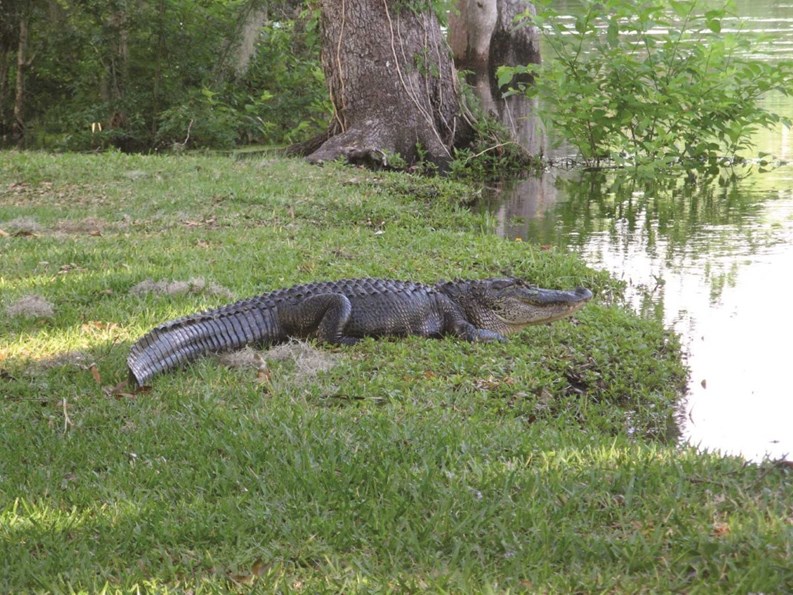In Florida, humans share space with all manner of reptiles; most noteworthy are alligators and several species of exotic snakes. Humans and reptiles thrive in Florida’s semi-tropical climate, and learning how to co-exist safely, is a human concern. It is entirely on mankind to work out the co-habitation details since alligators are an integral component of Florida’s freshwater ecosystem and protected by law.
Alligators have been adapting to an ever changing environment for 35 million years. In Florida ‘gators are holding their own at an estimated population of one to one and a half million. The U.S. Census Bureau lists the population of Florida at 18,801,310. People still have the edge, but when clashes with alligators or other reptiles do occur they are not pretty.
According to Senior Animal Care Specialist Cayle Pearson, human fatalities involving alligator attacks average out to one every other year. Non-fatal attacks average in the teens annually. Given the amount of news coverage these encounters generate, attacks appear more prevalent than the figures bear out.
Pearson notes that “it is illegal to engage an alligator in any way in the state of Florida, and that includes feeding.” He works as a trapper for Animal Trappers of Florida, and specializes in nuisance wildlife removal and relocation. “An alligator that has been fed loses any natural fear of humans, and then views people as a potential food source; a dangerous combination of factors.”
The building boom experienced statewide during the last decade displaced much of Florida’s wildlife, including alligators. Exposure to construction workers and food left behind at construction sites created an unnatural environment for the alligators. When building was finished and homeowners settled into newly developed areas, the gators often remained waiting for a hand out. More often than not this scenario played out badly for the reptiles. It didn’t matter that the gators were there first, there can be little tolerance for them when humans are endangered.
Retention ponds and drainage lakes are a prevalent part of all planned communities in Florida, and local folk lore claims all bodies of water larger than a bathtub will probably have at least one alligator. If an alligator displays aggressive behavior there is only one recommended course of action. Call the Nuisance Alligator Hotline (1-866-FWC-GATOR), a division of Florida Fish and Wildlife Conservation Commission.
A state licensed trapper can be dispatched to capture and remove any gator deemed a nuisance. Most trappers will use a snare or a noose to capture the animal. The snout is usually taped securely shut, and the alligator is transported in a metal box. Whether the alligator is relocated or destroyed is often a matter of size. An alligator of up to three or four feet may be successfully relocated to a remote area; larger gators will almost always be destroyed.
Alligators tend to move about at dusk and during the night while hunting for food and during mating season in April and May. This is normal behavior and should not be considered aggressive or threatening. However, it is never a good idea to walk close to any water’s edge at dusk or after dark. Alligators can typically lunge half their body length onto shore.
An alligator’s diet depends on availability, and they will eat anything up to and including other gators and pets. Most community newsletters encourage pet owners to stay well away from any water’s edge anytime while walking pets, and especially after dark. Alligators are also capable of moving swiftly on land for short distances. The speed at which an alligator can move makes this reptile a species to be respected on land and in the water.
After mating season, the female alligator will build her nest and lay up to fifty eggs. She will stay near the nest and defend it until the hatchlings appear after about 65 days. The hatchlings are typically 6-8 inches long, and they are easy prey. Few will survive until adulthood. During mating season, the smaller males will be pushed out of the watering holes and forced to find new quarters. This movement along with typical hunting behavior will sometimes bring the gators onto HOA property and cause problems with residents. According to the Florida Fish and Wildlife Conservation Commission, “The best course of action is to always avoid alligators, and call the Nuisance Hotline.” There are no known repellants or barriers that will successfully impede an alligator.
Pearson says that walls, or fencing that slants out at the top, do deter them but smaller alligators can actually climb chain link fences if sufficiently motivated.
Once an alligator reaches six feet it has outgrown all its natural predators and can continue to grow to thirteen or fourteen feet, and weigh between 800 and 1,000 pounds. The Everglades National Park website records the largest Florida alligator at seventeen feet, five inches, but the FFWCC website states the largest Florida alligator on record measured just less than fifteen feet. Alligators have been known to live over seventy years in European zoos, but no average life span has been established for this living fossil.
A cousin of the Florida alligator is the caiman; it has a U-shaped snout, is generally smaller and less fierce, and is found mostly in southern Florida. Native to Central and South America, the caiman is believed to have originally been brought to this county as a pet. Caimans became established in Florida presumably after owners realized their unsuitability as a pet and released this species into the wild. Another relative of the alligator is the crocodile. Crocodiles are an endangered species and tend towards secrecy, preferring the brackish coastal waters of extreme southern Florida.
Human conflicts with crocodiles and caimans are extremely rare, but the Nuisance Alligator Hotline will respond to any issues involving these reptiles. As with alligators, the hotline is the best course of action and under no circumstances should an untrained individual try to capture or contain one of these creatures.
Exotic Non-Native Snakes
There are other species of exotic reptiles that prefer southern Florida, specifically the Everglades regions, and their presence there is much more problematic than the native alligator or crocodile or even the non-native caiman.
Importation of Burmese pythons and Boa constrictors has led to serious problems in Florida. People seeking exotic pets are drawn to these extremely large and interesting snakes. Care and management for a pet that can grow to sixteen feet, 200 pounds, and live twenty to forty years can be daunting. Feeding and housing these snakes is both expensive and complicated. Although it is illegal to release pythons or boas into the wild, many people have done so. With the Everglades as a backyard, overwhelmed pet owners have released these massive snakes into Florida’s natural wetlands. The results have been devastating to many native birds and animals, including alligators. Alligators over six feet long now have a deadly predator in the Burmese python.
In addition to irresponsible pet owners, a common belief is that Hurricane Andrew released these exotic breeds of snakes from pet warehouses and zoos and the imported species have flourished and reproduced prolifically to the point of becoming invasive. There are reports that these breeds may migrate north into central Florida and south into Miami and the Florida Keys.
The U.S. Park Service website reported that over 1,330 pythons were recaptured by December 2009. There are legal repercussions including fines and jail time if a snake can be traced back to the original owner. That is nearly impossible, unless the snake has been implanted with a micro-chip.
The FFWCC has instituted a hunting program in order to bring the expanding snake population under control. From March 8 through April 17, annually, anyone with a hunting license may kill exotic, invasive snakes. There are even some financial incentives to harvesting pythons. Brian Wood, of All American Gator Products, Inc., a reptile processor located in Hallandale Beach, Florida pays $5 per foot for a whole snake. A pair of snakeskin trousers can be valued up to $900. Snake meat may also be sold, however the mercury level is high in snakes harvested from the Everglades and surrounding regions. Considered a delicacy, python meat is reported to taste “like chicken.”
The following myths and facts are listed on the University of Florida Institute of Food and Agricultural Sciences (IFAS) Extension webpage concerning common misconceptions about alligators:
Myth #1.You should run zigzag if you come across an alligator.
This is a misconception. It would be rare for an alligator to pursue a human because humans are too large to be suitable prey. If an alligator does make an aggressive charge, run fast and straight. An alligator would be most likely to charge at you if you were near their nest.
Myth #2.Alligators have poor eyesight.
Alligators have very good eyesight. They are adapted to both see and sense movement of potential prey. The position of their eyes, almost on the side on their head gives them a wide sight range. The only place an alligator cannot see is right behind them.
Myth #3.Alligators are not good climbers.
Alligators have sharp claws and powerful tails to help them climb. Young alligators are agile and adults have been known to climb fences. Low fences may not be sufficient protection for pets in areas where alligators are present. Fences should be more than 4.5 feet tall.
Myth #4.Alligators make good pets.
It is illegal to possess an alligator without the proper permits from the Florida Fish and Wildlife Conservation Commission. Alligators are instinctual hunters and do not show affection; they will never love the hand that feeds them, and pose a serious threat to life and limb as they get bigger and more aggressive with time.
Whether you live in Arizona and have to contend with gila monsters and diamondbacks, run into black bears in your backyard in the Northeast, or encounter alligators on your HOA's golf course, it's important to remember that even when we live side-by-side with wildlife, humans must remain respectful of Mother Nature. Alligators and other creatures were here long before we were, and taking them for granted or getting too friendly can mean trouble for both species.
Anne Childers is a freelance writer and a frequent contributor to The South Florida Cooperator.







Leave a Comment